Have village's 'natural' flood defences delivered?
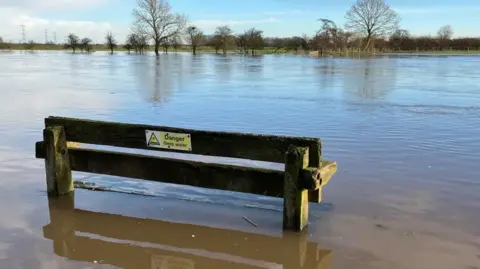 BBC
BBCLast year, residents in a Nottinghamshire village called for change after their houses were surrounded by flood water nine times in the span of three months.
Andy Palmer said he "almost broke down" because of a failure to pump water out of his Burton Joyce home during Storm Henk in January 2024, and Niki Papa said she nearly had to evacuate.
Meanwhile, Harriet Brown said dealing with the flooding had left her husband, Adam, mentally and physically exhausted.
She told the BBC the next flood would be one heavy rainfall away, unless action was taken.
The following month, Nottinghamshire County Council announced it would fund a £50,000 natural flood defence scheme, in partnership with the Trent Rivers Trust.
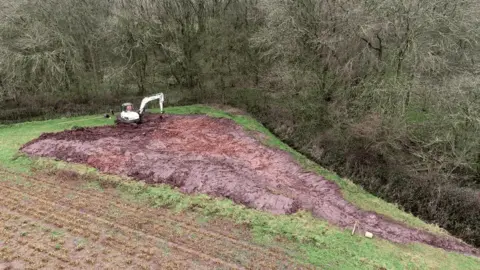 Trent Rivers Trust
Trent Rivers TrustCouncillor Neil Clarke, the council's cabinet member for transport and environment, said it was a "relatively small" sum, but that it had an outsized impact because of the situation which faced the village.
"Where you have a project that is going into millions of pounds, it quite often will not just be natural flood management, it will involve hefty infrastructure with pretty major pipework and pumping systems," he said.
"It wasn't really required because in this particular case [the water flow] came from the hillside and therefore you've got the natural gravity of water.
"The way to try and minimise flooding was to slow that water flow down and dissipate it so that it wasn't gushing down."
With the site already containing natural woodland, the council felt this would be the most appropriate response to Storm Henk, according to Clarke.
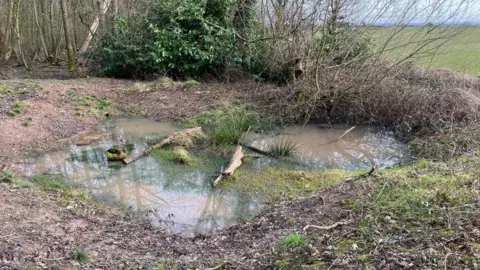
Upstream from Burton Joyce, at Crock Dumble, a new wetland area, a bund, two restored ponds, and 20 leaky barriers were built.
Nick Wilding, the natural based solutions manager at Trent Rivers Trust, said the intent was to turn the area into a "sponge" to absorb water and slow the flow.
The wetland area and bund slow rainwater, the ponds store excess water and slowly dissipate it into the nearby woodland, and the leaky barriers mimic the barriers built by beavers.
"Rather than water getting from A to B incredibly quickly, we're slowing the flow and temporarily storing it in areas where we haven't got infrastructure like houses and roads," Mr Wilding said.
The design was also intended to be resilient. Mr Wilding added: "If you were to implement a civic engineering solution to flooding, that wall is going to need maintenance over time.
"It's going to be quite expensive to implement, whereas if we can use the natural processes that were previously in place in our countryside, they will almost look after themselves."
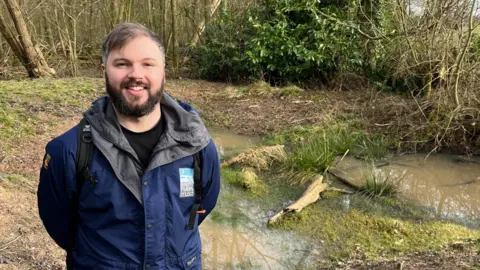
Will it work?
Judging the effectiveness of these measures is not as "complicated as you might expect" according to Mr Wilding.
"What we look for is wet ground, we're looking to see where water has been," he said.
This includes signs of trash-lines, where sticks and leaves have been deposited by flowing water. It also involves checking water pipes.
"[To find this] we could use fixed point photography, we could use timelapsed cameras, we could use level logging equipment," he said.
"It checks that water is going where we think it might go under certain conditions.
"What we can do is infer that what we've done is store water at a critical time and slow that flow of water down towards the village."
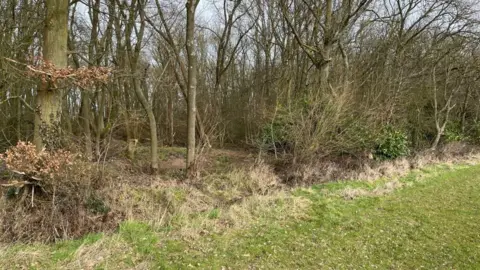
However, the word "infer" carries a lot of weight, because empirically proving a difference through advanced modelling is "expensive", says Mr Wilding.
"We are confident that the principles behind natural flood management are sound and that our efforts are protecting properties downstream," he said.
"Consultancies would charge a reasonable amount of money to go into the depth needed to 'empirically prove' something.
"It's not always needed, but sometimes that evidence is useful for future funding bids."
The residents
It is one thing to have an expert highlight the indicators that a scheme is working, it is another to see whether those impacted have felt a tangible difference.
The flooding in January this year provided the project with its first real litmus test.
Jackie Hollowell, a flood warden in Burton Joyce, said there had "absolutely" been an improvement downstream from Crock Dumble.
"The flooding from the riverside [last month] did come quite high, but we didn't have the same flooding at the point in the village where the Crock Dumble is," she said.
"With climate change, we've got this increasing prevalence of heavy downpours and flooding, and it's causing a lot of damage to people's properties, but it's also emotional [damage].
"I think £50,000 in these days is not an awful lot of money to have solved quite a big problem for the village."
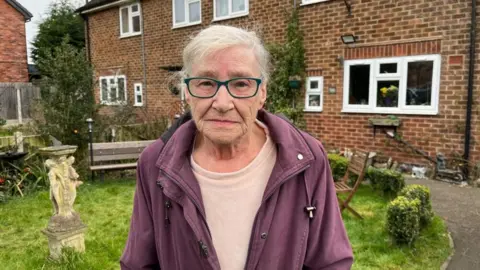
"It does help me sleep a lot better at night, because you're not thinking all the time about whether water will be in the house," said Glenis Downs.
She said there had been a noticeable difference when comparing January's floods, to that of previous years.
"It's been unbelievable, it's not been bad at all. There has been no flooding in the back garden, only the front, but that wasn't bad. It's been lovely," she said.
Niki Papa, a resident and owner of the local chip shop, also agreed with that assessment. He added: "It's definitely a lot better.
"I flooded several times [previously], and it was very concerning at one point, I nearly had to evacuate the house.
"There was one occasion where I couldn't access the front of my shop, because it was that flooded, but luckily this year nothing as yet."

The natural flood defences for Burton Joyce were paid for by Nottinghamshire County Council.
It is the lead local flood authority for the village, which means it plays a key role in emergency planning, as well as raising awareness of flood risks.
Neil Clarke said their spending priorities were correct.
"Flooding does appear to have minimised as a result of this project. It's about managing the water, not stopping it," he said.
Clarke added natural flood defences formed part of a "jigsaw" in protecting people's homes – in addition to clearing drains and gullies.
"What is important is that we continue working with all our partners, that might be the Environment Agency, it might be the Trent Rivers Trust," he said.
"We want to make sure that we can find the best ways to work together to minimise the amount of flooding."
Follow BBC Nottingham on Facebook, on X, or on Instagram. Send your story ideas to [email protected] or via WhatsApp on 0808 100 2210.
